Legislation, Case Law & Statutory Interpretation Assignment - 1031LAW
VerifiedAdded on 2022/10/04
|19
|4329
|181
Report
AI Summary
This report analyzes the Residential Tenancies and Rooming Accommodation Act 2008, focusing on its purpose, structure, and critical perspectives. It examines the rights and obligations of tenants, lessors, and agents in Queensland, the dispute resolution processes, and the Act's impact on the rental market. The report also includes a case analysis involving a nuisance claim related to a motel and a nearby apartment, examining the application of legal rules and the specifics of the tenancy agreement. The assignment assesses the student's ability to summarize legislation and a case, and apply statutory interpretation skills. The report concludes with a discussion of the legislation's fairness and effectiveness, and identifies potential unintended consequences and their solutions.
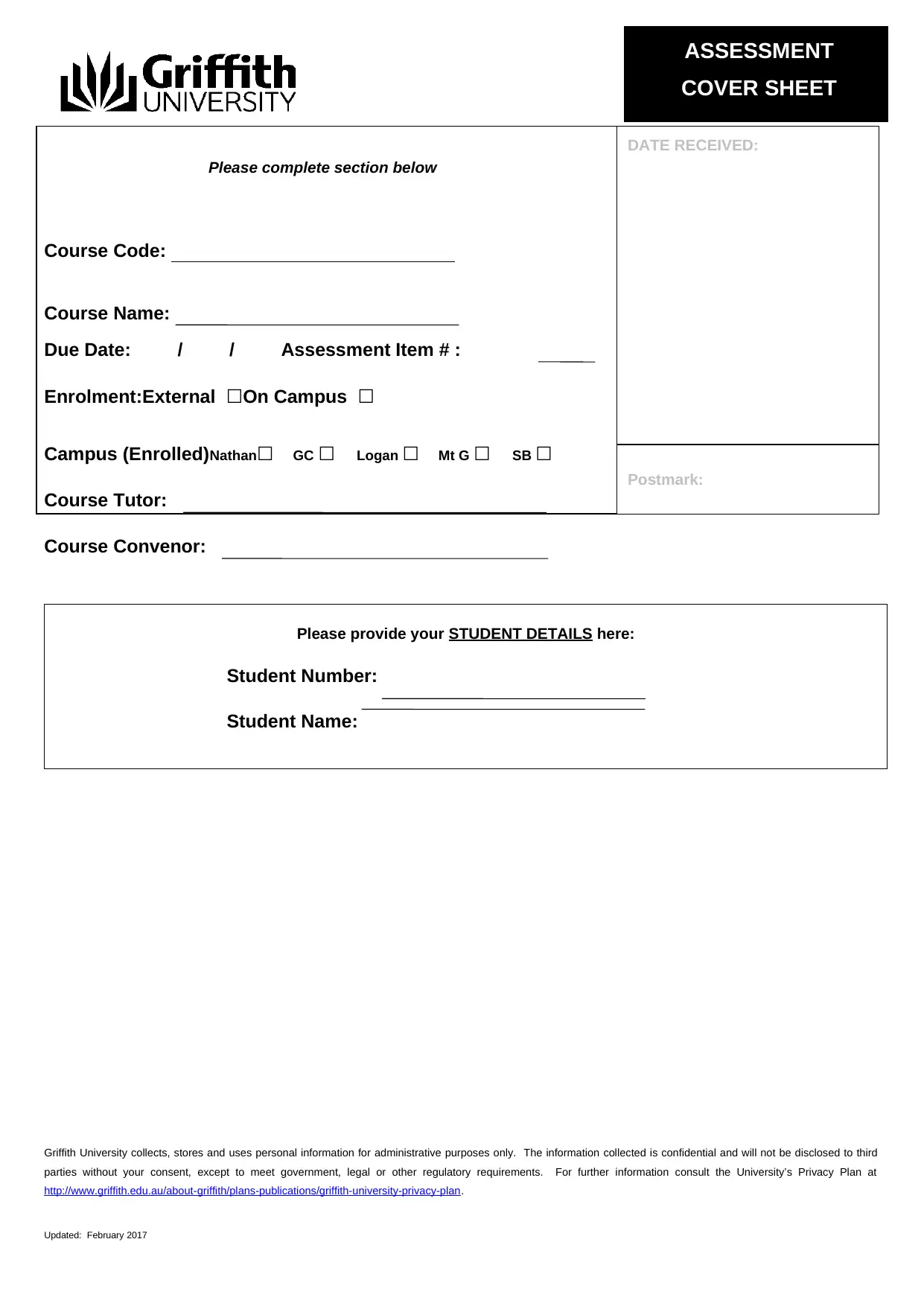
ASSESSMENT
COVER SHEET
Please complete section below
Course Code:
Course Name:
Due Date: / / Assessment Item # :
Enrolment:External ☐On Campus ☐
Campus (Enrolled)Nathan☐ GC ☐ Logan ☐ Mt G ☐ SB ☐
Course Tutor:
Course Convenor:
Please provide your STUDENT DETAILS here:
Student Number:
Student Name:
Griffith University collects, stores and uses personal information for administrative purposes only. The information collected is confidential and will not be disclosed to third
parties without your consent, except to meet government, legal or other regulatory requirements. For further information consult the University’s Privacy Plan at
http://www.griffith.edu.au/about-griffith/plans-publications/griffith-university-privacy-plan.
Updated: February 2017
DATE RECEIVED:
Postmark:
COVER SHEET
Please complete section below
Course Code:
Course Name:
Due Date: / / Assessment Item # :
Enrolment:External ☐On Campus ☐
Campus (Enrolled)Nathan☐ GC ☐ Logan ☐ Mt G ☐ SB ☐
Course Tutor:
Course Convenor:
Please provide your STUDENT DETAILS here:
Student Number:
Student Name:
Griffith University collects, stores and uses personal information for administrative purposes only. The information collected is confidential and will not be disclosed to third
parties without your consent, except to meet government, legal or other regulatory requirements. For further information consult the University’s Privacy Plan at
http://www.griffith.edu.au/about-griffith/plans-publications/griffith-university-privacy-plan.
Updated: February 2017
DATE RECEIVED:
Postmark:
Paraphrase This Document
Need a fresh take? Get an instant paraphrase of this document with our AI Paraphraser
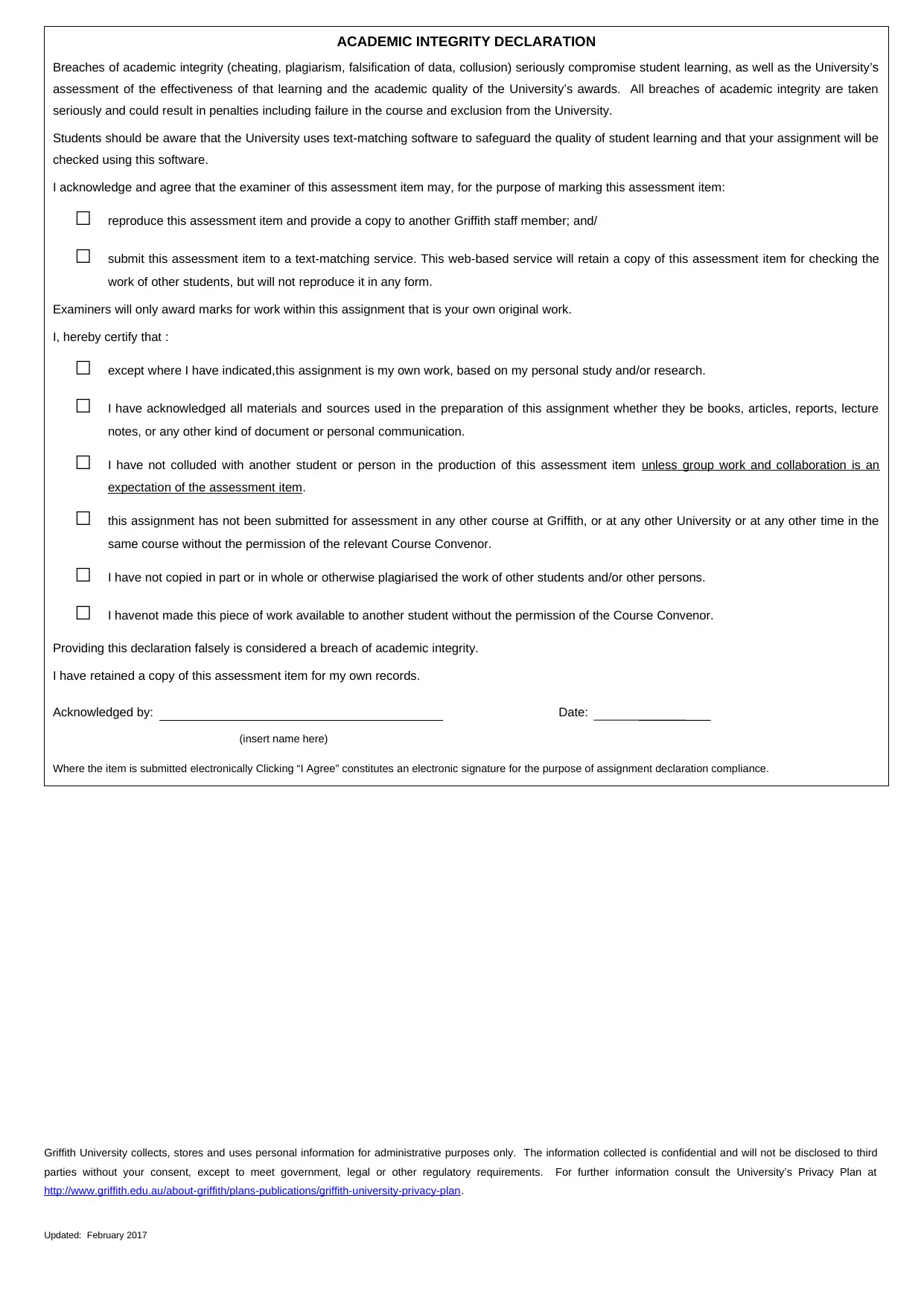
ACADEMIC INTEGRITY DECLARATION
Breaches of academic integrity (cheating, plagiarism, falsification of data, collusion) seriously compromise student learning, as well as the University’s
assessment of the effectiveness of that learning and the academic quality of the University’s awards. All breaches of academic integrity are taken
seriously and could result in penalties including failure in the course and exclusion from the University.
Students should be aware that the University uses text-matching software to safeguard the quality of student learning and that your assignment will be
checked using this software.
I acknowledge and agree that the examiner of this assessment item may, for the purpose of marking this assessment item:
☐ reproduce this assessment item and provide a copy to another Griffith staff member; and/
☐ submit this assessment item to a text-matching service. This web-based service will retain a copy of this assessment item for checking the
work of other students, but will not reproduce it in any form.
Examiners will only award marks for work within this assignment that is your own original work.
I, hereby certify that :
☐ except where I have indicated,this assignment is my own work, based on my personal study and/or research.
☐ I have acknowledged all materials and sources used in the preparation of this assignment whether they be books, articles, reports, lecture
notes, or any other kind of document or personal communication.
☐ I have not colluded with another student or person in the production of this assessment item unless group work and collaboration is an
expectation of the assessment item.
☐ this assignment has not been submitted for assessment in any other course at Griffith, or at any other University or at any other time in the
same course without the permission of the relevant Course Convenor.
☐ I have not copied in part or in whole or otherwise plagiarised the work of other students and/or other persons.
☐ I havenot made this piece of work available to another student without the permission of the Course Convenor.
Providing this declaration falsely is considered a breach of academic integrity.
I have retained a copy of this assessment item for my own records.
Acknowledged by: Date:
(insert name here)
Where the item is submitted electronically Clicking “I Agree” constitutes an electronic signature for the purpose of assignment declaration compliance.
Griffith University collects, stores and uses personal information for administrative purposes only. The information collected is confidential and will not be disclosed to third
parties without your consent, except to meet government, legal or other regulatory requirements. For further information consult the University’s Privacy Plan at
http://www.griffith.edu.au/about-griffith/plans-publications/griffith-university-privacy-plan.
Updated: February 2017
Breaches of academic integrity (cheating, plagiarism, falsification of data, collusion) seriously compromise student learning, as well as the University’s
assessment of the effectiveness of that learning and the academic quality of the University’s awards. All breaches of academic integrity are taken
seriously and could result in penalties including failure in the course and exclusion from the University.
Students should be aware that the University uses text-matching software to safeguard the quality of student learning and that your assignment will be
checked using this software.
I acknowledge and agree that the examiner of this assessment item may, for the purpose of marking this assessment item:
☐ reproduce this assessment item and provide a copy to another Griffith staff member; and/
☐ submit this assessment item to a text-matching service. This web-based service will retain a copy of this assessment item for checking the
work of other students, but will not reproduce it in any form.
Examiners will only award marks for work within this assignment that is your own original work.
I, hereby certify that :
☐ except where I have indicated,this assignment is my own work, based on my personal study and/or research.
☐ I have acknowledged all materials and sources used in the preparation of this assignment whether they be books, articles, reports, lecture
notes, or any other kind of document or personal communication.
☐ I have not colluded with another student or person in the production of this assessment item unless group work and collaboration is an
expectation of the assessment item.
☐ this assignment has not been submitted for assessment in any other course at Griffith, or at any other University or at any other time in the
same course without the permission of the relevant Course Convenor.
☐ I have not copied in part or in whole or otherwise plagiarised the work of other students and/or other persons.
☐ I havenot made this piece of work available to another student without the permission of the Course Convenor.
Providing this declaration falsely is considered a breach of academic integrity.
I have retained a copy of this assessment item for my own records.
Acknowledged by: Date:
(insert name here)
Where the item is submitted electronically Clicking “I Agree” constitutes an electronic signature for the purpose of assignment declaration compliance.
Griffith University collects, stores and uses personal information for administrative purposes only. The information collected is confidential and will not be disclosed to third
parties without your consent, except to meet government, legal or other regulatory requirements. For further information consult the University’s Privacy Plan at
http://www.griffith.edu.au/about-griffith/plans-publications/griffith-university-privacy-plan.
Updated: February 2017
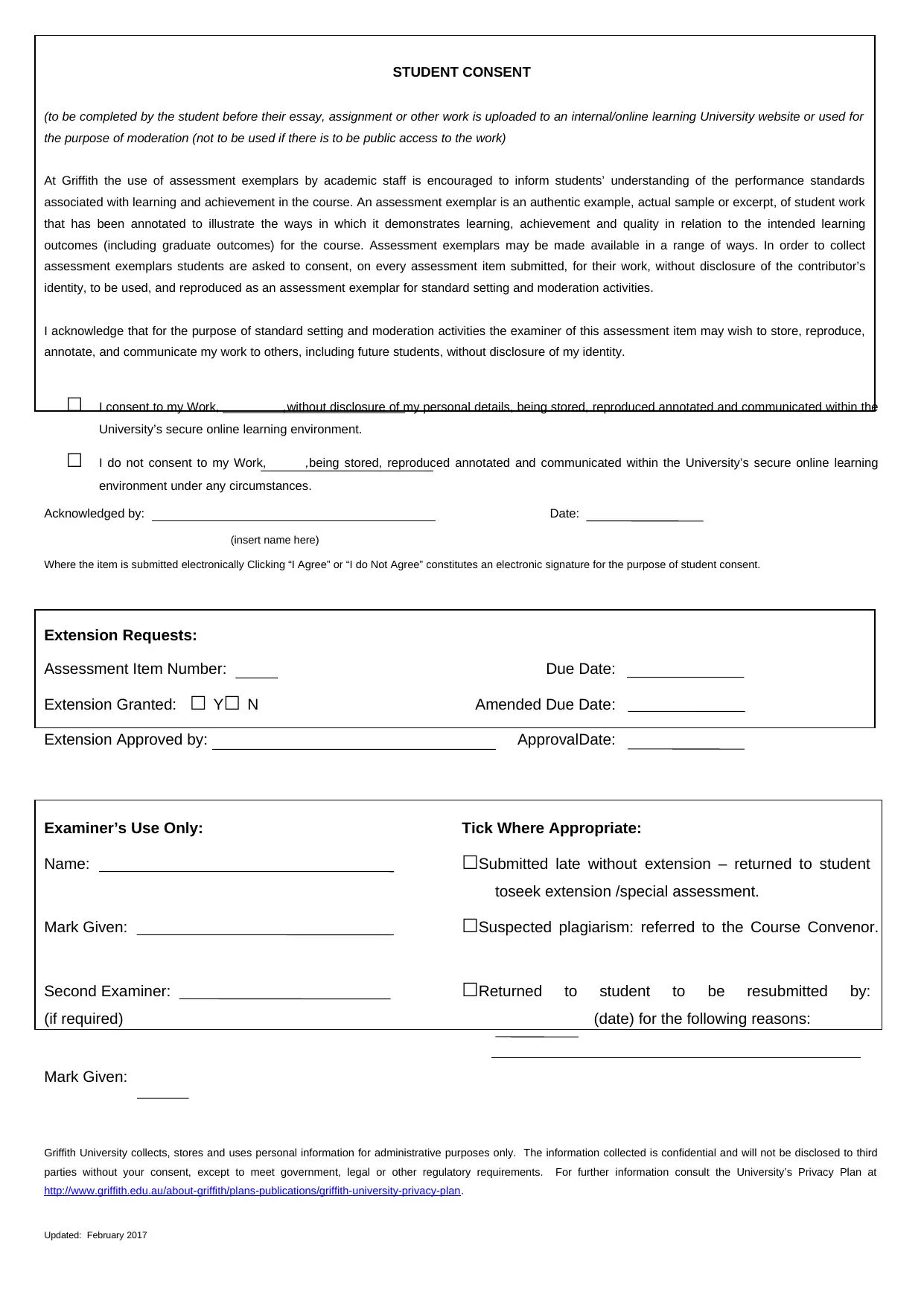
STUDENT CONSENT
(to be completed by the student before their essay, assignment or other work is uploaded to an internal/online learning University website or used for
the purpose of moderation (not to be used if there is to be public access to the work)
At Griffith the use of assessment exemplars by academic staff is encouraged to inform students’ understanding of the performance standards
associated with learning and achievement in the course. An assessment exemplar is an authentic example, actual sample or excerpt, of student work
that has been annotated to illustrate the ways in which it demonstrates learning, achievement and quality in relation to the intended learning
outcomes (including graduate outcomes) for the course. Assessment exemplars may be made available in a range of ways. In order to collect
assessment exemplars students are asked to consent, on every assessment item submitted, for their work, without disclosure of the contributor’s
identity, to be used, and reproduced as an assessment exemplar for standard setting and moderation activities.
I acknowledge that for the purpose of standard setting and moderation activities the examiner of this assessment item may wish to store, reproduce,
annotate, and communicate my work to others, including future students, without disclosure of my identity.
☐ I consent to my Work, ,without disclosure of my personal details, being stored, reproduced annotated and communicated within the
University’s secure online learning environment.
☐ I do not consent to my Work, ,being stored, reproduced annotated and communicated within the University’s secure online learning
environment under any circumstances.
Acknowledged by: Date:
(insert name here)
Where the item is submitted electronically Clicking “I Agree” or “I do Not Agree” constitutes an electronic signature for the purpose of student consent.
Extension Requests:
Assessment Item Number: Due Date:
Extension Granted: ☐ Y☐ N Amended Due Date:
Extension Approved by: ApprovalDate:
Examiner’s Use Only: Tick Where Appropriate:
Name: ☐Submitted late without extension – returned to student
toseek extension /special assessment.
Mark Given: ☐Suspected plagiarism: referred to the Course Convenor.
Second Examiner: ☐Returned to student to be resubmitted by:
(if required) (date) for the following reasons:
Mark Given:
Griffith University collects, stores and uses personal information for administrative purposes only. The information collected is confidential and will not be disclosed to third
parties without your consent, except to meet government, legal or other regulatory requirements. For further information consult the University’s Privacy Plan at
http://www.griffith.edu.au/about-griffith/plans-publications/griffith-university-privacy-plan.
Updated: February 2017
(to be completed by the student before their essay, assignment or other work is uploaded to an internal/online learning University website or used for
the purpose of moderation (not to be used if there is to be public access to the work)
At Griffith the use of assessment exemplars by academic staff is encouraged to inform students’ understanding of the performance standards
associated with learning and achievement in the course. An assessment exemplar is an authentic example, actual sample or excerpt, of student work
that has been annotated to illustrate the ways in which it demonstrates learning, achievement and quality in relation to the intended learning
outcomes (including graduate outcomes) for the course. Assessment exemplars may be made available in a range of ways. In order to collect
assessment exemplars students are asked to consent, on every assessment item submitted, for their work, without disclosure of the contributor’s
identity, to be used, and reproduced as an assessment exemplar for standard setting and moderation activities.
I acknowledge that for the purpose of standard setting and moderation activities the examiner of this assessment item may wish to store, reproduce,
annotate, and communicate my work to others, including future students, without disclosure of my identity.
☐ I consent to my Work, ,without disclosure of my personal details, being stored, reproduced annotated and communicated within the
University’s secure online learning environment.
☐ I do not consent to my Work, ,being stored, reproduced annotated and communicated within the University’s secure online learning
environment under any circumstances.
Acknowledged by: Date:
(insert name here)
Where the item is submitted electronically Clicking “I Agree” or “I do Not Agree” constitutes an electronic signature for the purpose of student consent.
Extension Requests:
Assessment Item Number: Due Date:
Extension Granted: ☐ Y☐ N Amended Due Date:
Extension Approved by: ApprovalDate:
Examiner’s Use Only: Tick Where Appropriate:
Name: ☐Submitted late without extension – returned to student
toseek extension /special assessment.
Mark Given: ☐Suspected plagiarism: referred to the Course Convenor.
Second Examiner: ☐Returned to student to be resubmitted by:
(if required) (date) for the following reasons:
Mark Given:
Griffith University collects, stores and uses personal information for administrative purposes only. The information collected is confidential and will not be disclosed to third
parties without your consent, except to meet government, legal or other regulatory requirements. For further information consult the University’s Privacy Plan at
http://www.griffith.edu.au/about-griffith/plans-publications/griffith-university-privacy-plan.
Updated: February 2017
⊘ This is a preview!⊘
Do you want full access?
Subscribe today to unlock all pages.

Trusted by 1+ million students worldwide

Examiner’s Comments:
Griffith University collects, stores and uses personal information for administrative purposes only. The information collected is confidential and will not be disclosed to third
parties without your consent, except to meet government, legal or other regulatory requirements. For further information consult the University’s Privacy Plan at
http://www.griffith.edu.au/about-griffith/plans-publications/griffith-university-privacy-plan.
Updated: February 2017
Griffith University collects, stores and uses personal information for administrative purposes only. The information collected is confidential and will not be disclosed to third
parties without your consent, except to meet government, legal or other regulatory requirements. For further information consult the University’s Privacy Plan at
http://www.griffith.edu.au/about-griffith/plans-publications/griffith-university-privacy-plan.
Updated: February 2017
Paraphrase This Document
Need a fresh take? Get an instant paraphrase of this document with our AI Paraphraser
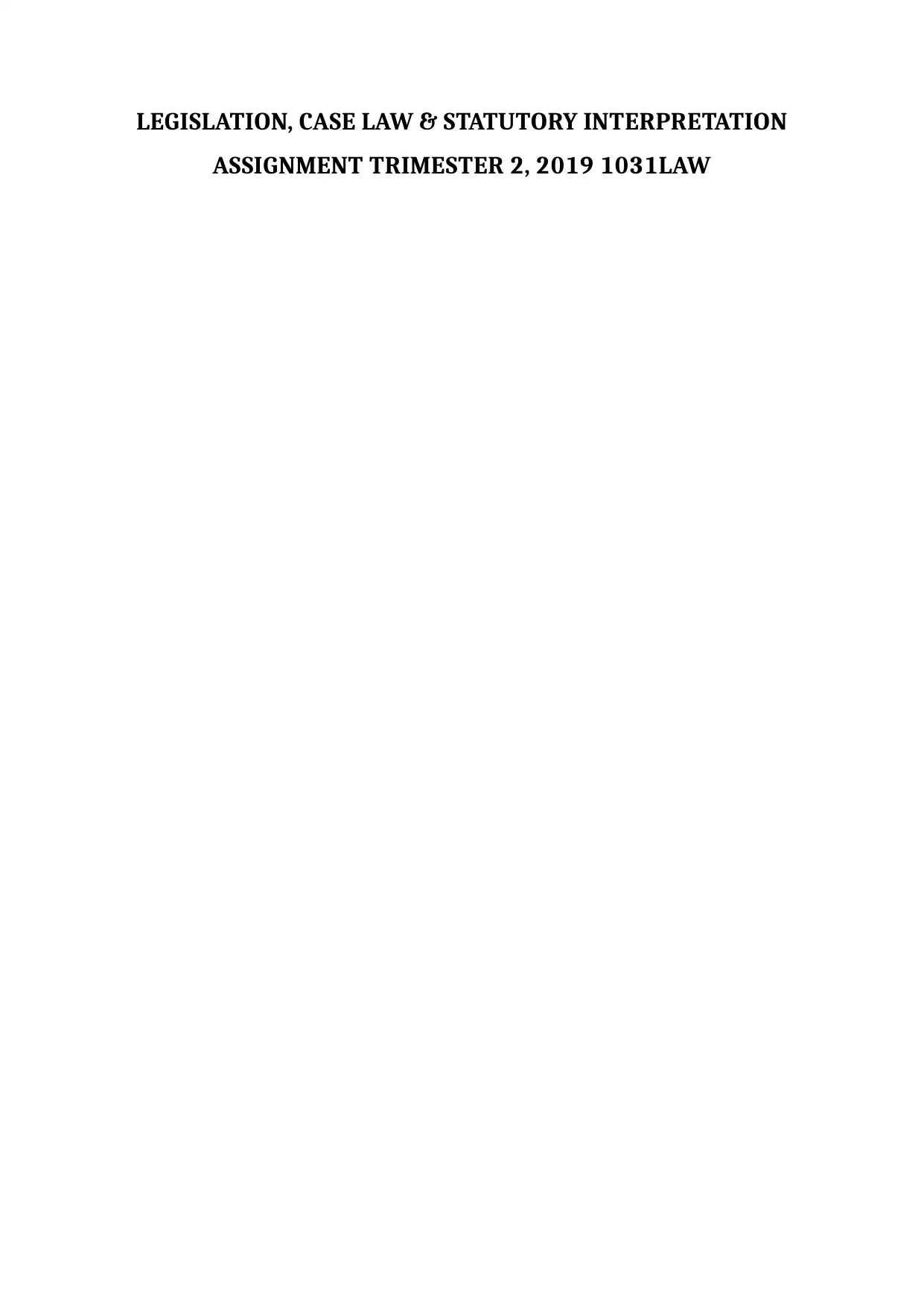
LEGISLATION, CASE LAW & STATUTORY INTERPRETATION
ASSIGNMENT TRIMESTER 2, 2019 1031LAW
ASSIGNMENT TRIMESTER 2, 2019 1031LAW
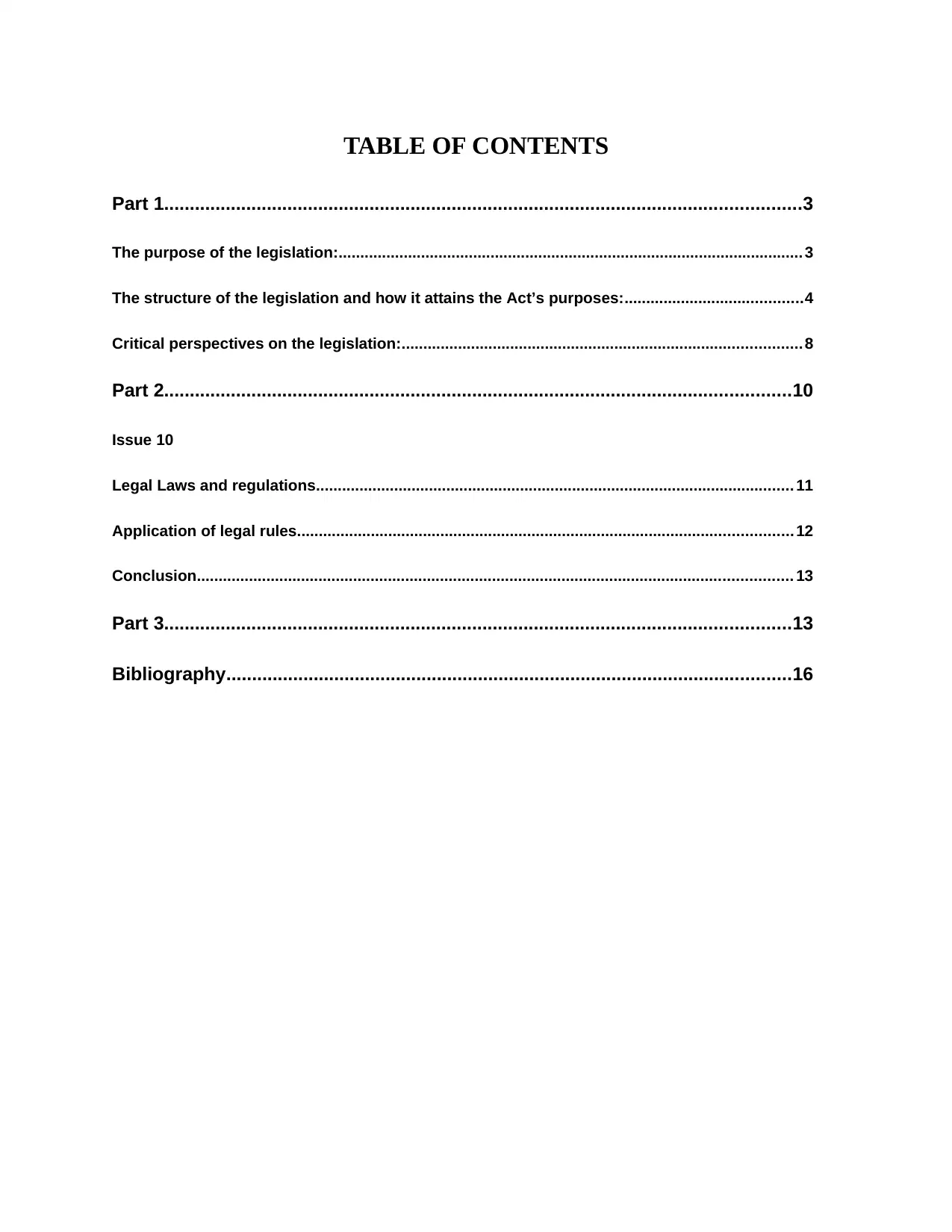
TABLE OF CONTENTS
Part 1............................................................................................................................3
The purpose of the legislation:........................................................................................................... 3
The structure of the legislation and how it attains the Act’s purposes:.........................................4
Critical perspectives on the legislation:............................................................................................ 8
Part 2..........................................................................................................................10
Issue 10
Legal Laws and regulations.............................................................................................................. 11
Application of legal rules.................................................................................................................. 12
Conclusion......................................................................................................................................... 13
Part 3..........................................................................................................................13
Bibliography..............................................................................................................16
Part 1............................................................................................................................3
The purpose of the legislation:........................................................................................................... 3
The structure of the legislation and how it attains the Act’s purposes:.........................................4
Critical perspectives on the legislation:............................................................................................ 8
Part 2..........................................................................................................................10
Issue 10
Legal Laws and regulations.............................................................................................................. 11
Application of legal rules.................................................................................................................. 12
Conclusion......................................................................................................................................... 13
Part 3..........................................................................................................................13
Bibliography..............................................................................................................16
⊘ This is a preview!⊘
Do you want full access?
Subscribe today to unlock all pages.

Trusted by 1+ million students worldwide
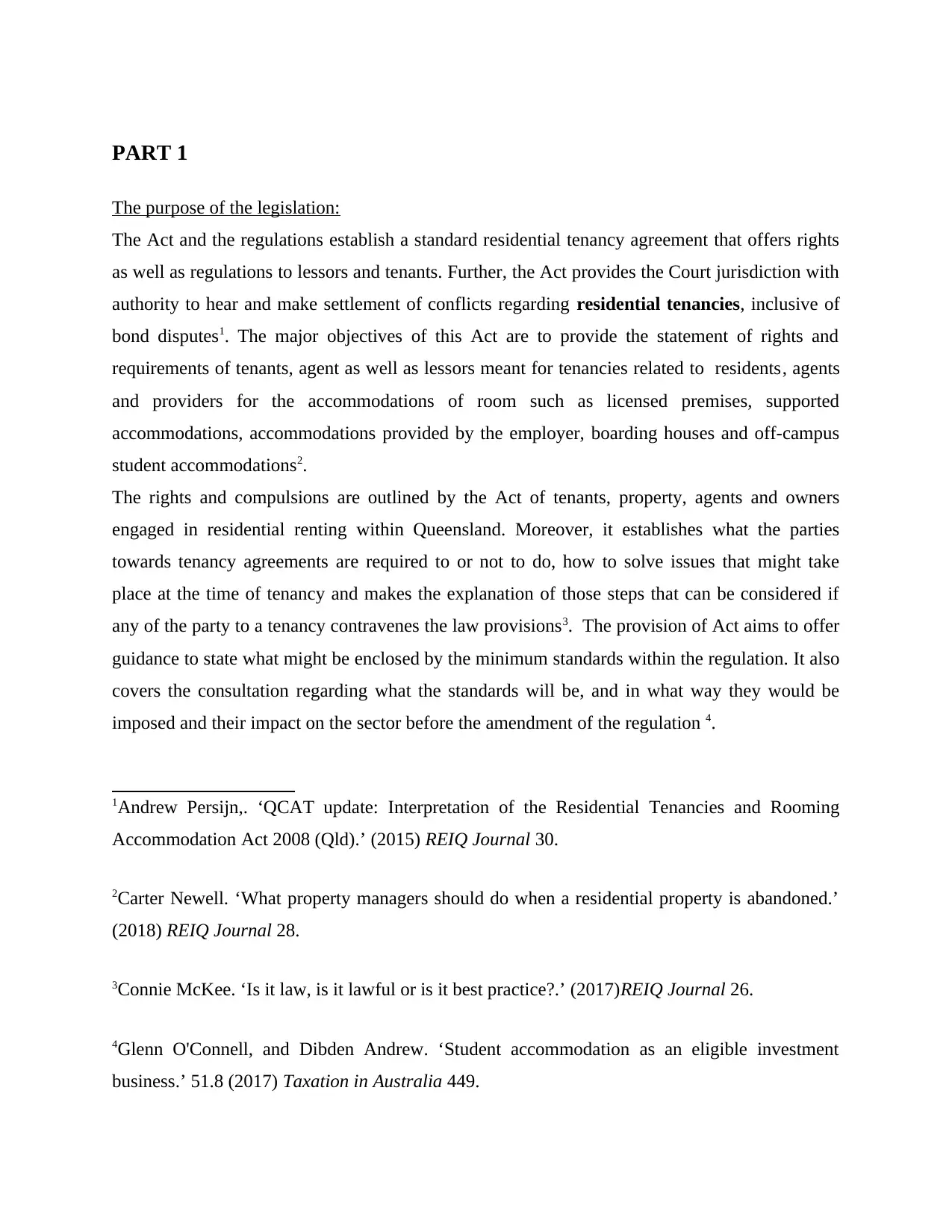
PART 1
The purpose of the legislation:
The Act and the regulations establish a standard residential tenancy agreement that offers rights
as well as regulations to lessors and tenants. Further, the Act provides the Court jurisdiction with
authority to hear and make settlement of conflicts regarding residential tenancies, inclusive of
bond disputes1. The major objectives of this Act are to provide the statement of rights and
requirements of tenants, agent as well as lessors meant for tenancies related to residents, agents
and providers for the accommodations of room such as licensed premises, supported
accommodations, accommodations provided by the employer, boarding houses and off-campus
student accommodations2.
The rights and compulsions are outlined by the Act of tenants, property, agents and owners
engaged in residential renting within Queensland. Moreover, it establishes what the parties
towards tenancy agreements are required to or not to do, how to solve issues that might take
place at the time of tenancy and makes the explanation of those steps that can be considered if
any of the party to a tenancy contravenes the law provisions3. The provision of Act aims to offer
guidance to state what might be enclosed by the minimum standards within the regulation. It also
covers the consultation regarding what the standards will be, and in what way they would be
imposed and their impact on the sector before the amendment of the regulation 4.
1Andrew Persijn,. ‘QCAT update: Interpretation of the Residential Tenancies and Rooming
Accommodation Act 2008 (Qld).’ (2015) REIQ Journal 30.
2Carter Newell. ‘What property managers should do when a residential property is abandoned.’
(2018) REIQ Journal 28.
3Connie McKee. ‘Is it law, is it lawful or is it best practice?.’ (2017)REIQ Journal 26.
4Glenn O'Connell, and Dibden Andrew. ‘Student accommodation as an eligible investment
business.’ 51.8 (2017) Taxation in Australia 449.
The purpose of the legislation:
The Act and the regulations establish a standard residential tenancy agreement that offers rights
as well as regulations to lessors and tenants. Further, the Act provides the Court jurisdiction with
authority to hear and make settlement of conflicts regarding residential tenancies, inclusive of
bond disputes1. The major objectives of this Act are to provide the statement of rights and
requirements of tenants, agent as well as lessors meant for tenancies related to residents, agents
and providers for the accommodations of room such as licensed premises, supported
accommodations, accommodations provided by the employer, boarding houses and off-campus
student accommodations2.
The rights and compulsions are outlined by the Act of tenants, property, agents and owners
engaged in residential renting within Queensland. Moreover, it establishes what the parties
towards tenancy agreements are required to or not to do, how to solve issues that might take
place at the time of tenancy and makes the explanation of those steps that can be considered if
any of the party to a tenancy contravenes the law provisions3. The provision of Act aims to offer
guidance to state what might be enclosed by the minimum standards within the regulation. It also
covers the consultation regarding what the standards will be, and in what way they would be
imposed and their impact on the sector before the amendment of the regulation 4.
1Andrew Persijn,. ‘QCAT update: Interpretation of the Residential Tenancies and Rooming
Accommodation Act 2008 (Qld).’ (2015) REIQ Journal 30.
2Carter Newell. ‘What property managers should do when a residential property is abandoned.’
(2018) REIQ Journal 28.
3Connie McKee. ‘Is it law, is it lawful or is it best practice?.’ (2017)REIQ Journal 26.
4Glenn O'Connell, and Dibden Andrew. ‘Student accommodation as an eligible investment
business.’ 51.8 (2017) Taxation in Australia 449.
Paraphrase This Document
Need a fresh take? Get an instant paraphrase of this document with our AI Paraphraser
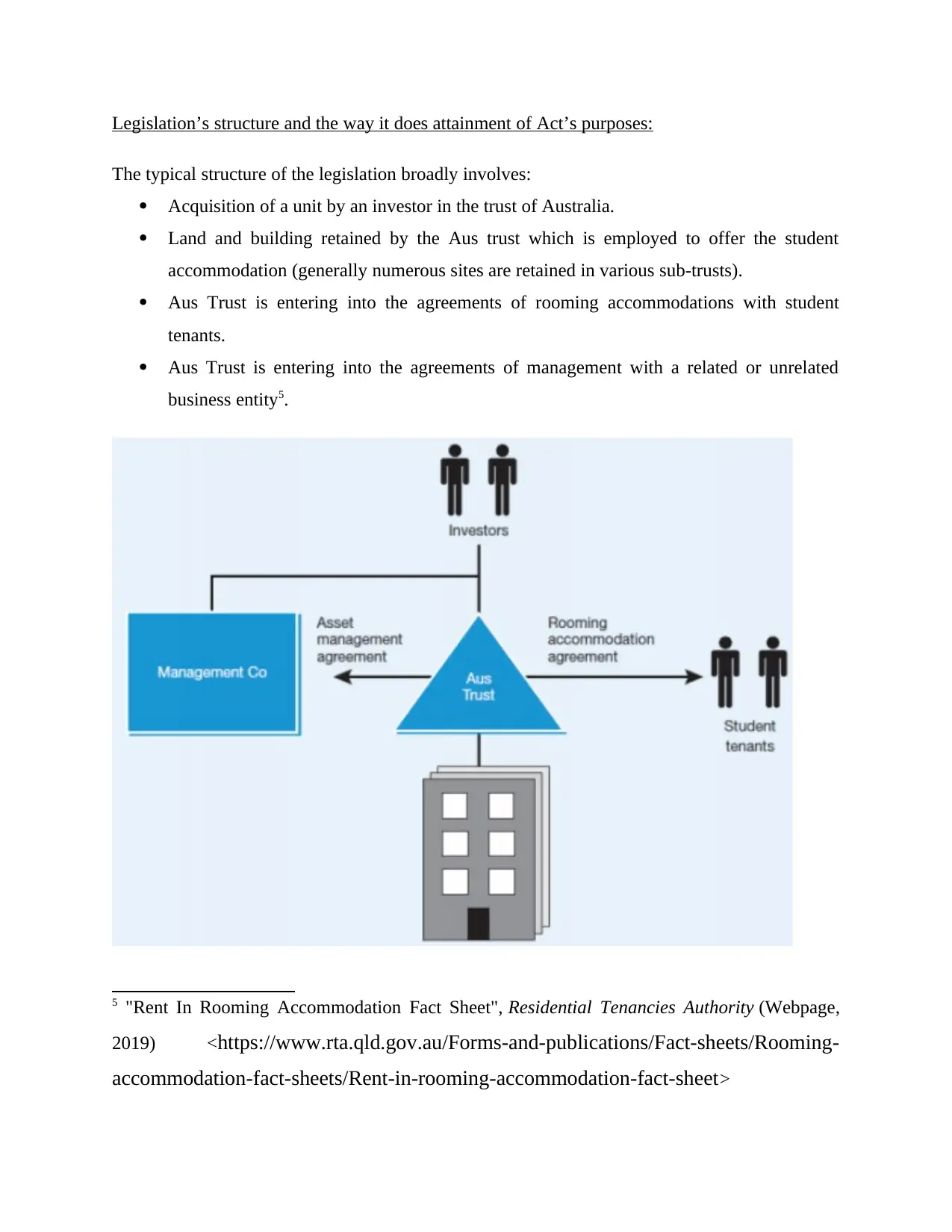
Legislation’s structure and the way it does attainment of Act’s purposes:
The typical structure of the legislation broadly involves:
Acquisition of a unit by an investor in the trust of Australia.
Land and building retained by the Aus trust which is employed to offer the student
accommodation (generally numerous sites are retained in various sub-trusts).
Aus Trust is entering into the agreements of rooming accommodations with student
tenants.
Aus Trust is entering into the agreements of management with a related or unrelated
business entity5.
5 "Rent In Rooming Accommodation Fact Sheet", Residential Tenancies Authority (Webpage,
2019) <https://www.rta.qld.gov.au/Forms-and-publications/Fact-sheets/Rooming-
accommodation-fact-sheets/Rent-in-rooming-accommodation-fact-sheet>
The typical structure of the legislation broadly involves:
Acquisition of a unit by an investor in the trust of Australia.
Land and building retained by the Aus trust which is employed to offer the student
accommodation (generally numerous sites are retained in various sub-trusts).
Aus Trust is entering into the agreements of rooming accommodations with student
tenants.
Aus Trust is entering into the agreements of management with a related or unrelated
business entity5.
5 "Rent In Rooming Accommodation Fact Sheet", Residential Tenancies Authority (Webpage,
2019) <https://www.rta.qld.gov.au/Forms-and-publications/Fact-sheets/Rooming-
accommodation-fact-sheets/Rent-in-rooming-accommodation-fact-sheet>
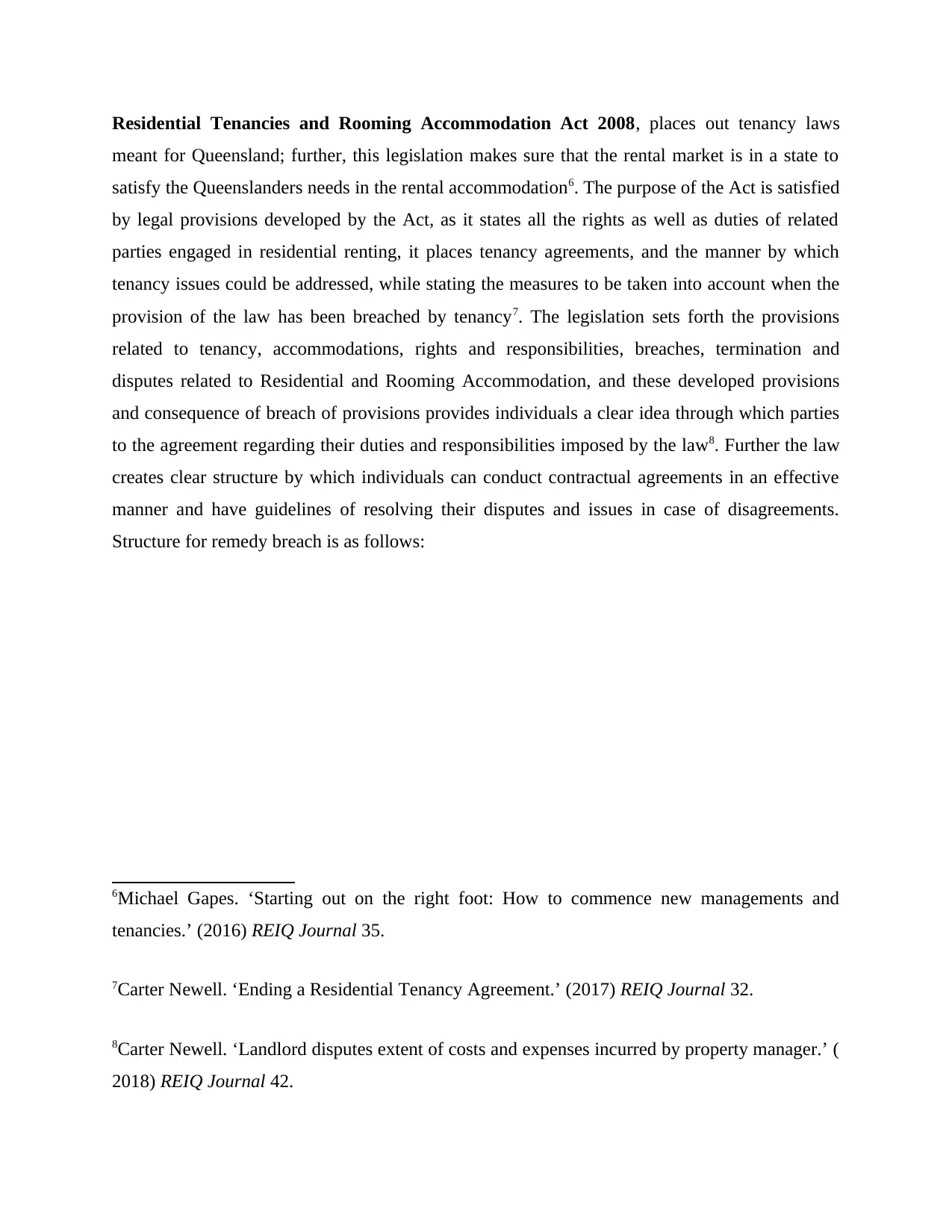
Residential Tenancies and Rooming Accommodation Act 2008, places out tenancy laws
meant for Queensland; further, this legislation makes sure that the rental market is in a state to
satisfy the Queenslanders needs in the rental accommodation6. The purpose of the Act is satisfied
by legal provisions developed by the Act, as it states all the rights as well as duties of related
parties engaged in residential renting, it places tenancy agreements, and the manner by which
tenancy issues could be addressed, while stating the measures to be taken into account when the
provision of the law has been breached by tenancy7. The legislation sets forth the provisions
related to tenancy, accommodations, rights and responsibilities, breaches, termination and
disputes related to Residential and Rooming Accommodation, and these developed provisions
and consequence of breach of provisions provides individuals a clear idea through which parties
to the agreement regarding their duties and responsibilities imposed by the law8. Further the law
creates clear structure by which individuals can conduct contractual agreements in an effective
manner and have guidelines of resolving their disputes and issues in case of disagreements.
Structure for remedy breach is as follows:
6Michael Gapes. ‘Starting out on the right foot: How to commence new managements and
tenancies.’ (2016) REIQ Journal 35.
7Carter Newell. ‘Ending a Residential Tenancy Agreement.’ (2017) REIQ Journal 32.
8Carter Newell. ‘Landlord disputes extent of costs and expenses incurred by property manager.’ (
2018) REIQ Journal 42.
meant for Queensland; further, this legislation makes sure that the rental market is in a state to
satisfy the Queenslanders needs in the rental accommodation6. The purpose of the Act is satisfied
by legal provisions developed by the Act, as it states all the rights as well as duties of related
parties engaged in residential renting, it places tenancy agreements, and the manner by which
tenancy issues could be addressed, while stating the measures to be taken into account when the
provision of the law has been breached by tenancy7. The legislation sets forth the provisions
related to tenancy, accommodations, rights and responsibilities, breaches, termination and
disputes related to Residential and Rooming Accommodation, and these developed provisions
and consequence of breach of provisions provides individuals a clear idea through which parties
to the agreement regarding their duties and responsibilities imposed by the law8. Further the law
creates clear structure by which individuals can conduct contractual agreements in an effective
manner and have guidelines of resolving their disputes and issues in case of disagreements.
Structure for remedy breach is as follows:
6Michael Gapes. ‘Starting out on the right foot: How to commence new managements and
tenancies.’ (2016) REIQ Journal 35.
7Carter Newell. ‘Ending a Residential Tenancy Agreement.’ (2017) REIQ Journal 32.
8Carter Newell. ‘Landlord disputes extent of costs and expenses incurred by property manager.’ (
2018) REIQ Journal 42.
⊘ This is a preview!⊘
Do you want full access?
Subscribe today to unlock all pages.

Trusted by 1+ million students worldwide
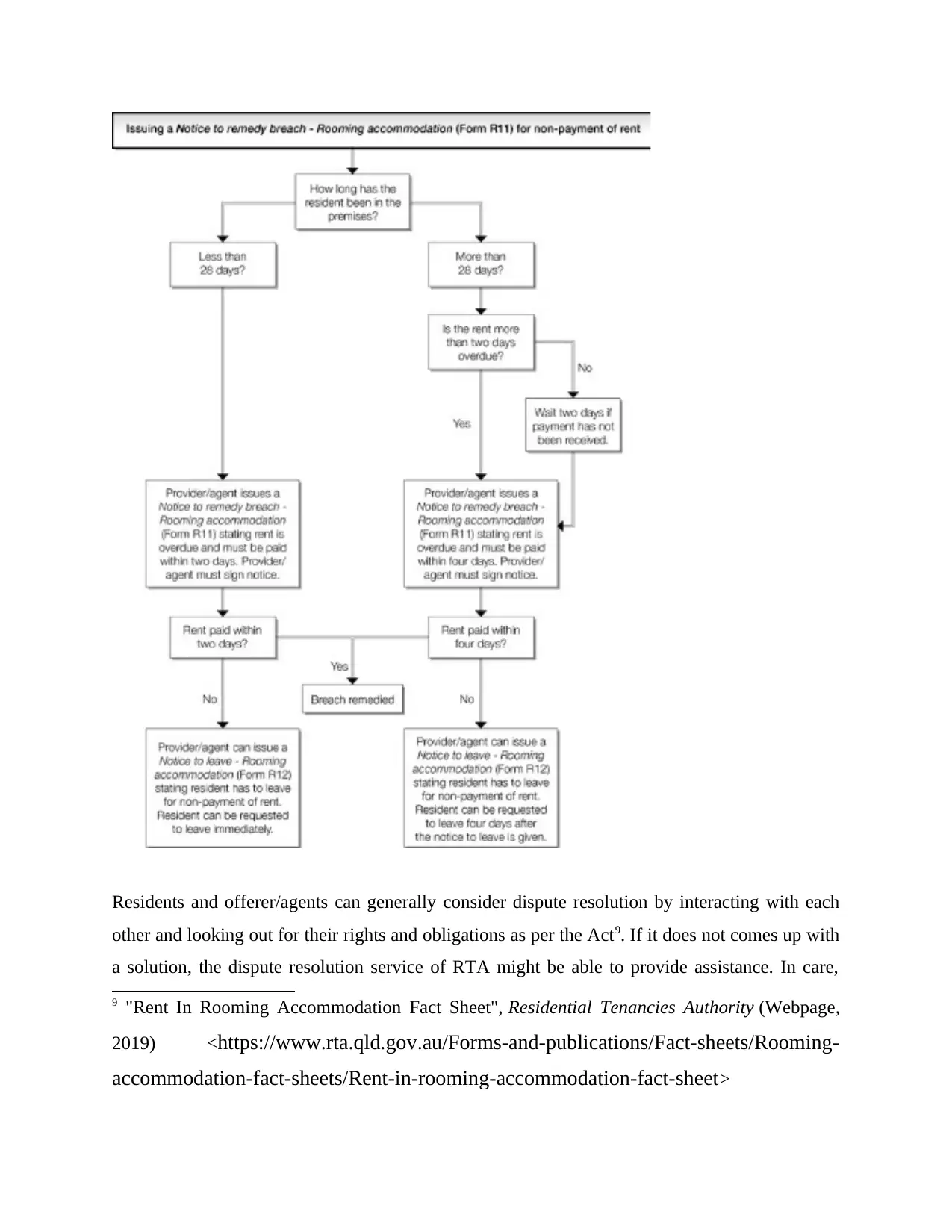
Residents and offerer/agents can generally consider dispute resolution by interacting with each
other and looking out for their rights and obligations as per the Act9. If it does not comes up with
a solution, the dispute resolution service of RTA might be able to provide assistance. In care,
9 "Rent In Rooming Accommodation Fact Sheet", Residential Tenancies Authority (Webpage,
2019) <https://www.rta.qld.gov.au/Forms-and-publications/Fact-sheets/Rooming-
accommodation-fact-sheets/Rent-in-rooming-accommodation-fact-sheet>
other and looking out for their rights and obligations as per the Act9. If it does not comes up with
a solution, the dispute resolution service of RTA might be able to provide assistance. In care,
9 "Rent In Rooming Accommodation Fact Sheet", Residential Tenancies Authority (Webpage,
2019) <https://www.rta.qld.gov.au/Forms-and-publications/Fact-sheets/Rooming-
accommodation-fact-sheets/Rent-in-rooming-accommodation-fact-sheet>
Paraphrase This Document
Need a fresh take? Get an instant paraphrase of this document with our AI Paraphraser

there is still no agreement, and an application is required to be prepared to the Tribunal for the
final decision10.
This Act is a combination of flexibility and rigidness as it prescribes terms that are required to be
included in the agreement referred to as standard terms. On the other hand, the parties might be
agreeable to other special terms given they do not disagree or are not consistent with the standard
terms11.
Critical perspectives on the legislation:
By considering the above facts, it can be stated that this Act is expected to attain its ultimate
purpose, as it has set out clear and defined guidelines and provisions, and these are likely to be
attained by the regulation of creating, content, process as well as termination of agreements,
offering for the dispute solving and formulating the Residential Tenancies Authority to obtain,
and make payment of rental bonds, while monitoring and imposing compliance with the
Act12.However, this act has some unintended consequences such as higher cost and balancing
higher flexibility with managing legislative simplicity, as well as neglecting potential unintended
results, for example, lessors/agents ending agreements to prevent applicable long-term
arrangements. Further, this could be solved by making amendments in the Act to make a
reduction in inspection frequency and enable notice periods to end a tenancy, in the absence of
grounds when the tenant has been in the premises for over two years13. Further unintended
consequences identified in the legislation are inefficiencies and costs that are enforced on the
10Sharon A Christensen., and DuncanWilliam D. ‘Sharing your home in Queensland: Host,
landlord or innkeeper?.’ 6.2 (2016)Property Law Review 137-143.
11William D Duncan., and Christensen Sharon. Real Estate Agency Law in QLD. (Thomson
Reuters, 2016)
12Sean Roberts. ‘Changes to Realworks property management forms.’ (2018) REIQ Journal 25.
13Sharon A Christensen., and Duncan William D. ‘Sharing your home in Queensland: Host,
landlord or innkeeper?.’ 6.2 (2016)Property Law Review 137-143.
final decision10.
This Act is a combination of flexibility and rigidness as it prescribes terms that are required to be
included in the agreement referred to as standard terms. On the other hand, the parties might be
agreeable to other special terms given they do not disagree or are not consistent with the standard
terms11.
Critical perspectives on the legislation:
By considering the above facts, it can be stated that this Act is expected to attain its ultimate
purpose, as it has set out clear and defined guidelines and provisions, and these are likely to be
attained by the regulation of creating, content, process as well as termination of agreements,
offering for the dispute solving and formulating the Residential Tenancies Authority to obtain,
and make payment of rental bonds, while monitoring and imposing compliance with the
Act12.However, this act has some unintended consequences such as higher cost and balancing
higher flexibility with managing legislative simplicity, as well as neglecting potential unintended
results, for example, lessors/agents ending agreements to prevent applicable long-term
arrangements. Further, this could be solved by making amendments in the Act to make a
reduction in inspection frequency and enable notice periods to end a tenancy, in the absence of
grounds when the tenant has been in the premises for over two years13. Further unintended
consequences identified in the legislation are inefficiencies and costs that are enforced on the
10Sharon A Christensen., and DuncanWilliam D. ‘Sharing your home in Queensland: Host,
landlord or innkeeper?.’ 6.2 (2016)Property Law Review 137-143.
11William D Duncan., and Christensen Sharon. Real Estate Agency Law in QLD. (Thomson
Reuters, 2016)
12Sean Roberts. ‘Changes to Realworks property management forms.’ (2018) REIQ Journal 25.
13Sharon A Christensen., and Duncan William D. ‘Sharing your home in Queensland: Host,
landlord or innkeeper?.’ 6.2 (2016)Property Law Review 137-143.

property owners and on the building industry from the regulatory measures that are external of
the building law structure14.
Yes, it creates a fair balance among the competing rights or the interest involves, it is because it
has set out specified rules and responsibilities for all involved parties, and positioned cases and
provisions that are meant to help them to adhere with the law, and it has also placed the
resolution aspects that can be applied to address disputes. It can be stated that this particular
legislation is fair towards all, and does not possess any sort of partiality in any other way, by
providing regulations with all parties to the contract and by considering overall interest. The
concept of this legislation does not adopt any particular theoretical model; however, the approach
of this model is based on dual rental sector model to ensure uniformity.
14Andrew Persijn,. ‘Lessor's obligations-When is a premises fit to live in and in good repair.’
(2018) REIQ Journal 36.
the building law structure14.
Yes, it creates a fair balance among the competing rights or the interest involves, it is because it
has set out specified rules and responsibilities for all involved parties, and positioned cases and
provisions that are meant to help them to adhere with the law, and it has also placed the
resolution aspects that can be applied to address disputes. It can be stated that this particular
legislation is fair towards all, and does not possess any sort of partiality in any other way, by
providing regulations with all parties to the contract and by considering overall interest. The
concept of this legislation does not adopt any particular theoretical model; however, the approach
of this model is based on dual rental sector model to ensure uniformity.
14Andrew Persijn,. ‘Lessor's obligations-When is a premises fit to live in and in good repair.’
(2018) REIQ Journal 36.
⊘ This is a preview!⊘
Do you want full access?
Subscribe today to unlock all pages.

Trusted by 1+ million students worldwide
1 out of 19
Related Documents
Your All-in-One AI-Powered Toolkit for Academic Success.
+13062052269
info@desklib.com
Available 24*7 on WhatsApp / Email
![[object Object]](/_next/static/media/star-bottom.7253800d.svg)
Unlock your academic potential
Copyright © 2020–2025 A2Z Services. All Rights Reserved. Developed and managed by ZUCOL.





